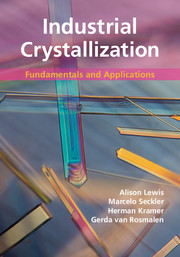Book contents
- Frontmatter
- Contents
- Nomenclature
- Industrial crystallization in practice: from process to product
- 1 Thermodynamics, crystallization methods and supersaturation
- 2 Characterization of a crystalline product
- 3 Basic process design for crystallization
- 4 Nucleation
- 5 Crystal growth
- 6 Agglomeration
- 7 The population balance equation
- 8 Batch crystallization
- 9 Measuring techniques
- 10 Industrial crystallizers
- 11 Precipitation and anti-solvent crystallization
- 12 Melt crystallization
- 13 Additives and impurities
- 14 Polymorphism
- Index
- References
1 - Thermodynamics, crystallization methods and supersaturation
Published online by Cambridge University Press: 05 July 2015
- Frontmatter
- Contents
- Nomenclature
- Industrial crystallization in practice: from process to product
- 1 Thermodynamics, crystallization methods and supersaturation
- 2 Characterization of a crystalline product
- 3 Basic process design for crystallization
- 4 Nucleation
- 5 Crystal growth
- 6 Agglomeration
- 7 The population balance equation
- 8 Batch crystallization
- 9 Measuring techniques
- 10 Industrial crystallizers
- 11 Precipitation and anti-solvent crystallization
- 12 Melt crystallization
- 13 Additives and impurities
- 14 Polymorphism
- Index
- References
Summary
Why this chapter is important
As crystallization is concerned with the phase change in solid–liquid systems, analysis of crystallization processes starts with consideration of phase diagrams. In this chapter we will show how phase diagrams help to select a crystallization method, and to determine the yield and the temperature of a crystallization process. The industrially relevant features of the main crystallization methods are also presented.
We next consider the state of the liquid phase during crystallization processes. The solution is said to be supersaturated with respect to the crystallizing compound, meaning the solute concentration is higher than the solid–liquid equilibrium value. The degree of supersaturation is important because it is the driving force for the elementary rate processes of crystallization, such as nucleation and crystal growth. Therefore, expressions to determine the degree of supersaturation are presented, both rigorous expressions based on thermodynamics and less rigorous expressions commonly found in practice.
In order to calculate the degree of supersaturation, thermodynamic models that provide the activity coefficients of the solute are required. The main models available are compared, so that the most suitable model may be chosen, depending on the accuracy, the ease of obtaining model experimental parameters and the types of building units (simple organic molecules, biomolecules, electrolytes, etc.).
Phase diagrams
Phase diagrams display all the possible thermodynamic states of a system: the proportion and the composition of each coexisting phase. The thermodynamic states are described by a set of independently fixed variables, such as the pressure, the temperature and the mass fractions of all components but one (since the sum of the mass fractions of all components must be unity). For a binary system at constant pressure, the phase diagram may be represented by a two-dimensional T–x plot, where T is the system temperature and x is the mass fraction of one of the components, as exemplified for the silver nitrate–water system at atmospheric pressure in Figure 1.1.
- Type
- Chapter
- Information
- Industrial CrystallizationFundamentals and Applications, pp. 1 - 25Publisher: Cambridge University PressPrint publication year: 2015



